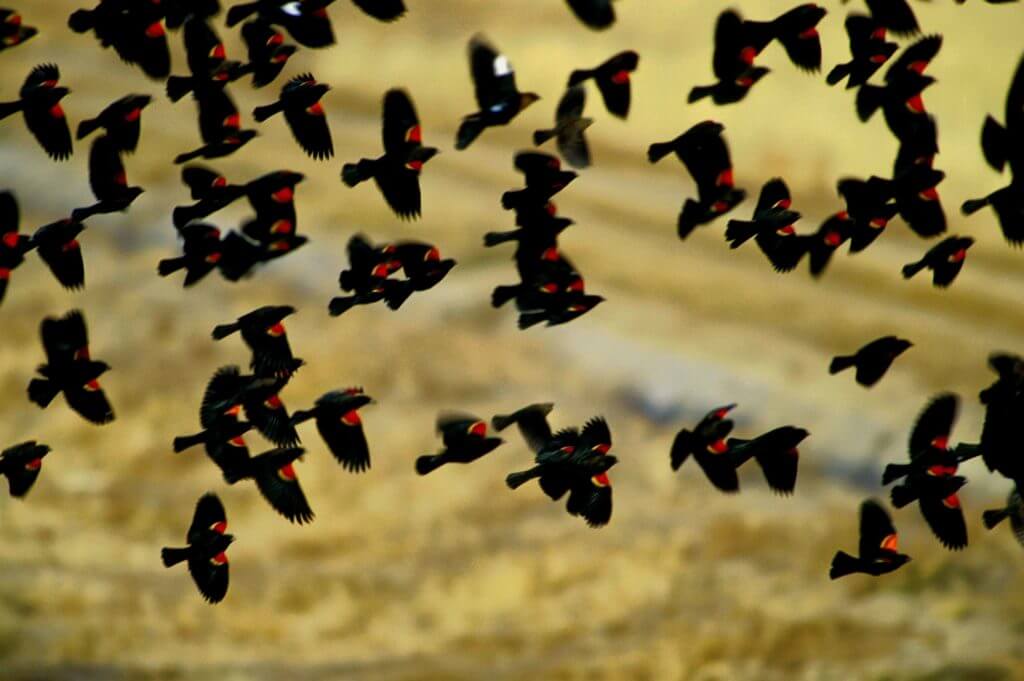Blackbird Flocks
by Danielle Lattuga
Broadcast 3.12 and 3.17.2017

Listen:
Red-winged blackbirds are a common species in Montana and I’d seen plenty of them together, particularly near ponds and lakes. But in winter, they can flock in congregations of millions of birds that include other species of blackbirds and starlings.
On a warm winter’s day, my husband and I were driving one of the dirt roads that meander through Montana’s Mission Valley. Patches of snow and mud checkered the fields around us and our eyes searched the fence lines for signs that might call attention to our dream property. As we drove slowly around a curve and began to ascend a small hill, something far more lively caught our attention: a huge flock of black birds was camped across the roadway. Some fluttered from ground to telephone wire. Some hopped about in the dry, dormant grasses along the roadside. The whole flock pulsed and flickered busily before our eyes. We rolled down the windows to hear the ruckus they surely made and were instantly enamored with all the activity the birds brought to an otherwise sleepy day. As we watched them, several of the birds took flight together and I noticed the telltale flash of a few red shoulders.
“I had no idea red-winged blackbirds hang out in such big flocks!” I remarked.
Red-winged blackbirds are a common species in Montana and I’d seen plenty of them together, particularly near ponds and lakes. But I’d never seen such a large flock—in winter, no less.
As it turns out, these industrious birds roost in smaller numbers during summer, when they are breeding, and they spend much of that time in wetland habitat. But in winter, they can flock in congregations of millions of birds that include other species of blackbirds and starlings. These larger flocks spend more of their time in agricultural fields, pastures, and grasslands, where they can find fall and winter forage of seeds and grains.
The large flock can offer two main benefits to individual birds: For one, red-winged blackbirds learn which new foods to try by carefully watching what other blackbirds are eating. Also, the flock can offer a great deal of protection: When the birds are eating, they are more likely to notice a predator and warn the other birds in the flock. What’s more, hawks have trouble singling out a bird from the tight, fast-moving group on the wing.
After watching the flock forage and flit about for a while, we slowly inched our car forward so that we could continue along the road. When we got close enough, the whole flock took flight and we couldn’t help but respond with a joyful “whoop!”
We didn’t find our dream property that day but I am certain that when the flock took off, they lifted both our spirits with them.
Every week since 1991, Field Notes has inquired about Montana’s natural history. Field Notes are written by naturalists, students, and listeners about the puzzle-tree bark, eagle talons, woolly aphids, and giant puffballs of Western, Central and Southwestern Montana and aired weekly on Montana Public Radio.
Click here to read and listen to more Field Notes. Field Notes is available as a podcast! Subscribe on iTunes, Google Play, or wherever you listen to podcasts.
Interested in writing a Field Note? Contact Allison De Jong, Field Notes editor, at adejong [at] montananaturalist [dot] org or 406.327.0405.
Want to learn more about our programs as well as fun natural history facts and seasonal phenology? Sign up for our e-newsletter! You can also become a member and get discounts on our programs as well as free reciprocal admission to 300+ science centers in North America!












